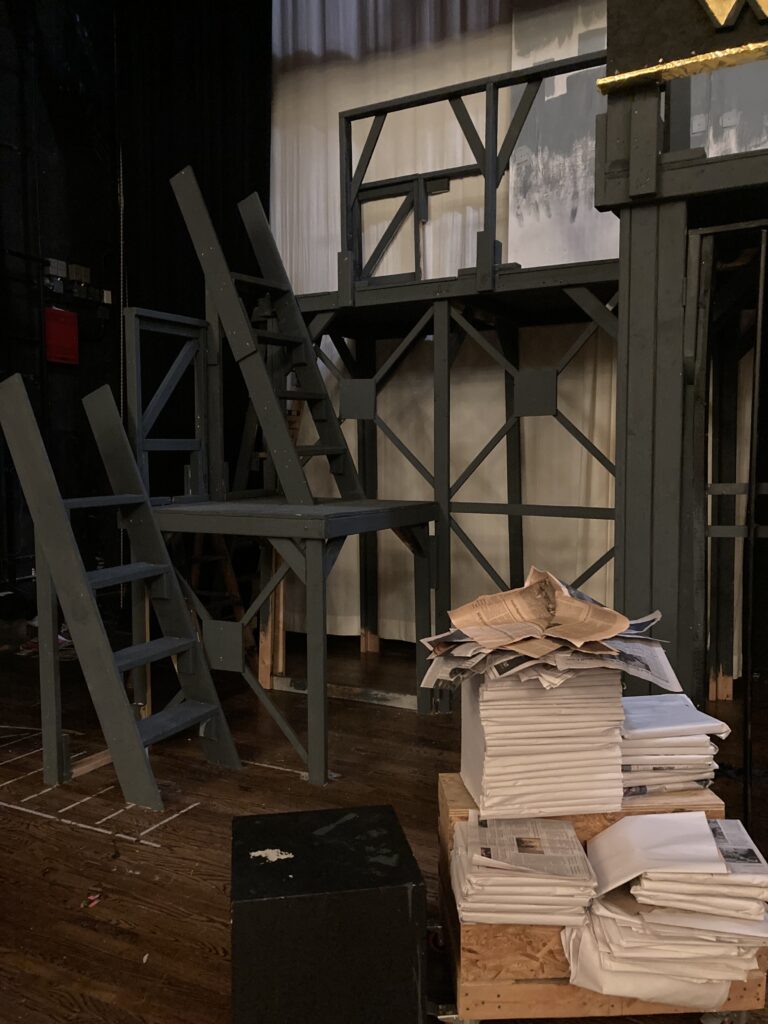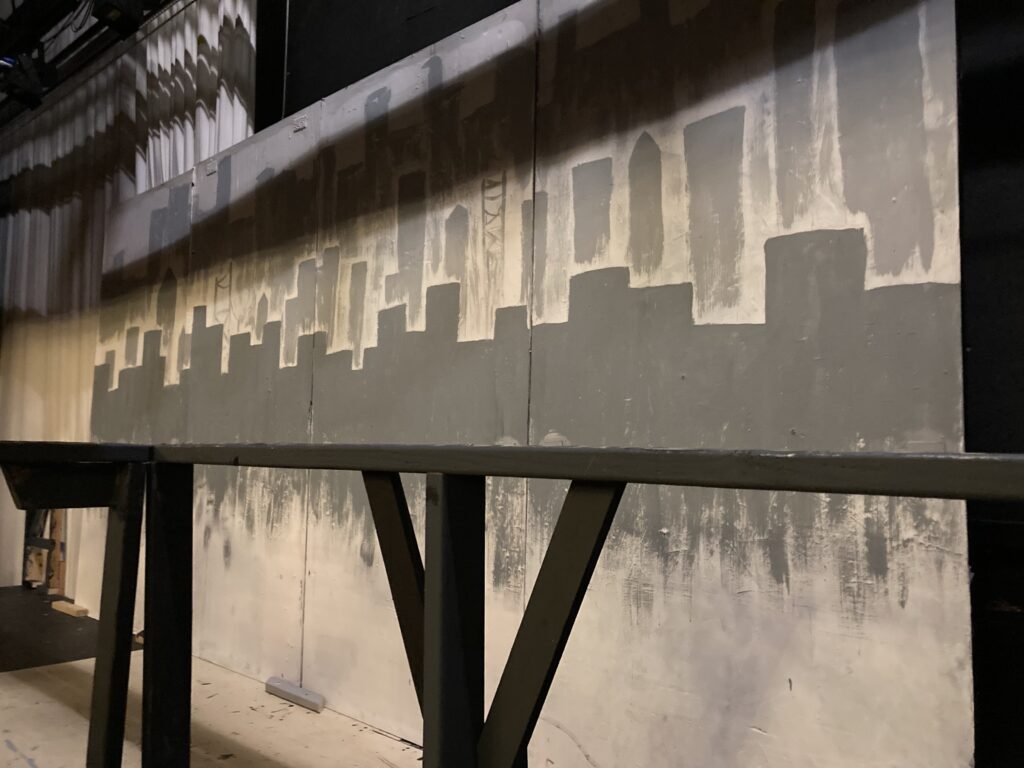Another school semester, another musical. Fall, 2023.

I have never seen or heard of Newsies before working on this production. Apparently I have sinned; but I am not really into theater. I am not a musical fan nor a musical consumer. I rarely go to plays, read them, or know enough about the culture. Simply, I make the sets. Set design requires aesthetic and construction skills. I have previously mentioned that my experience started with Sister Act during student teaching which subsequently encouraged me into Seussical—a lot of stumbling and a huge learning curve in that experience.
Newsies. After watching the recorded Disney® theater production, the set could not match that level, but we could build something similar in its idea and representation. Essentially, the boys sleep and live in the city streets finding shelter and refuge in the fire escapes of the buildings. In this consideration, we design levels of platforms accessible by a series of ladders and have the whole ensemble perform around and on it. My hindsight presented me my shortsightedness. I followed some other design when I should have learned more history to develop something original. Lessons learned if I work another set design. So imitating that steel industrial look, we set about with 8 foot platforms accessed by ladders all accessorized with cross braces painted in steel grey.
My crew was middle school students who just wanted to have fun. Luckily I have worked with a few them in two other productions (How to Eat Like A Child and Beauty and The Beast, Jr.). Their familiarity and experience allowed some confidence with the group’s ability to tackle this large set. Additionally, I have the high school BackStage Crew—a school club meeting after school to learn theatre design as a crash course while making sets for the high school musical. They provided the mentorship as supervisors and additional support. Yet, I pushed the limits of these groups with this huge construction. Taking a big risk of tiring the kids and not completing the project. However, each large platform raised ignited excitement and enthusiasm in the middle school group. Once they were giving charge with essential pieces such as ladders, rails, decorative braces, backgrounds, signs, newspaper props and desks they just went with it. Many mistakes were made, but that is how we learn. The proposed set came to be.











What about the printing press?
The press becomes an element at a pivotal point in the plot. Sure, I may be expressing too much importance on a machine; but, like the Gutenberg press, this object exponentially disseminates the newsies story making them more likely to be successful. A flat piece of plywood rolled onto the stage would be acceptable, but a working one or something that has a bit more presence could step up the production level. Could we rent one? The closest available one was two hours away and not impressive for the travel effort. Should we make one? How were we to make it? The Disney production appeared to have an authentic machine. Those things weigh a ton figuratively speaking.
Eventually, the web provided an answer. Bob Popielarczyk presented his working model in this 2019 video. With extreme number of repeated viewings at slow frame rates, screen scaling and close analysis of screen captures I could not see how the plywood structure worked so smoothly. After days of investigation and simply opening my eyes, I learned that Bob had integrated wooden gears. When he cranks the small gear that spins the large metal-looking wheel in the front, a larger gear smoothly sets the pistons in motion. Not having the tools, nor the time to learn through trial and error, I developed a blueprint for a hacked design sans gears. Maybe I could approach the drive directly at the piston wheel that sat at the back of his design. Would the motion still be the same? Before investing hours of labor and money, do the smart thing and produce a prototype.

Constructed of scrap cardboard, popsicle sticks and Q-tip stems, the basic structure seemed to have some resemblance to its reference, and maybe a similar performance(?).
Applying the force directly to the piston wheel, it moved in a full rotation. At the start, there was a small slip but maybe that occurred because it is just a small model made with cardboard and popsicle sticks. Somewhat shocked that it had worked, I proceeded to scale the prototype blueprint for a large-format model.

Because I am realist where some people call a pessimist, I had little confidence this would work. I was right.
Gathering up scrap wood from previous shows in the spirit of material economy, I pushed on.

Throughout the process, it was looking good. Too good to be true.

Not sure of the right length, I tested using longer pieces with room for adjustments. Using the original rough calculations, it did not work. Several attempts of tinkering provided no positive outcomes. It was all just haphazard tweaks. The pistons were too short or too long; their axles were not correctly located; parts were too tall or thick. After two weeks of crafting modifications nothing was working. Tech week was fast approaching; and it was scheduled after a three-day holiday weekend. So what did I do? Took everything home for those three days, I disassembled most of it to rebuild and test each part step by step. Eventually, the bare frame of the this prop roughly worked. The moves were choppy requiring too much effort at one arc and then slipping at the opposite slapping surfaces together with so much force the whole structure threatened to fall over. In the right position, foot on an added base piece, the operator could hold it in place while the machine jerked them around. My goal and promise was to have a working prop resembling an authentic machine. Not even close, and not like the one that inspired my development. Still, better than just not performing at all. MIT-level engineering skills were definitely required for this to function. I don’t know how Bob did it.

Note the student having difficulty due to my lack of great engineering knowledge. Nevertheless, it was done. On opening night the actors with their initial performance jitters forgot to crank the handle. They just looked at it pretending to expertly assess that this machine could crank out the newsie newsletter protesting the man. Nobody saw it perform. My holiday weekend of rest was lost; my time wasted. In the two other shows, the press was just a static prop. Still, the shows were great: the sets looked great; the performers played great; my stage crew was great.
